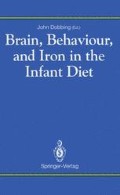Abstract
Iron deficiency is well known as the most common cause of childhood anemia. For this reason, the detection of anemia has been widely used as the primary screening for iron deficiency. Even though anemia represents only one of the many adverse consequences of iron deficiency, it is by far the best known, so that anemia, iron deficiency, and iron-deficiency anemia are often used as inter-changeable terms. In a strict clinical definition, the only cases of anemia that can be classified as iron-deficiency anemia are those with biochemical iron deficiency. However, for practical purposes, a presumed clinical diagnosis of iron deficiency and treatment with iron can be justified on the presence of anemia alone, since childhood anemia is so often the result of iron deficiency. For the same reason, monitoring the prevalence of anemia can yield helpful epidemiological information on the iron nutrition status of a population.
Access this chapter
Tax calculation will be finalised at checkout
Purchases are for personal use only
Preview
Unable to display preview. Download preview PDF.
References
Dallman PR, Yip R, Johnson C (1984) Prevalence and causes of anemia in the United States, 1976 to 1980. Am J Clin Nutr 39: 437–445
Expert Scientific Working Group (1985) Summary of a report on assessment of the iron nutrition status of the United States population. Am J Clin Nutr 42: 1318–1330
Galen RS, Gambino SR (1975) Beyond normality: the predictive value and efficiency of medical diagnosis. John Wiley and Sons, New York
Committee on Nutrition, American Academy of Pediatrics (1985) Nutrition Handbook American Academy of Pediatrics, Elk Grove Village, Illinois
Hillman RS, Finch CA (1985) Red cell manual, 5th edn. FA Davis, Philadelphia, pp 56–98
Lozoff B, Brittenham GM, Viteri FE, Wolf AW, Urrutia JJ (1982) Developmental deficits in iron deficient infants: effects of age and severity of iron lack. J Pediatr 101: 948–952
Vazquez-Seoane, P, Windom R, Pearson HA (1985) Disappearance of iron deficiency anemia in a high risk infant population given supplemental iron. N Engl J Med 313: 1239–1240
Miller V, Swaney S, Deinard AS (1985) Impact of the WIC program on the iron status of infants. Pediatrics 75: 100–105
Yip R, Binkin NJ, Flashood L, Trowbridge FL (1987) Declining prevalence of anemia among low-income children in the United States. JAMA 258: 1619–1623
Yip R, Walsh KM, Goldfarb MG, Binkin NJ (1987) Declining prevalence of anemia in childhood in a middle-class setting: a pediatric success story? Pediatrics 80: 330–334
Yip R, Binkin NJ, Trowbridge FL (1986) Declining childhood anemia prevalence in the US: evidence of improving iron nutrition. Blood 68: 51a
Human Nutrition Information Service (1985) National food consumption survey: continuing survey of food intakes by individuals: women 19–50 years and their children 1–5 years, 1 day, 1985, US Dept of Agriculture NFCS, CSFII report 85–1
Rush D, Leighton JL, Slaon NL, Alvir JM, et al. (1988) The national WIC evaluation, VI. Study of infants and children. Am J Clin Nutr 48: 484–511
Committee on Nutrition, American Academy of Pediatrics (1976) Iron supplementation for infants. Pediatrics 58: 765–768
Martinez GA, Nalezienski JP (1979) The recent trend in breast-feeding. Pediatrics 64: 686–692
MacKay HMM (1931) Anemia in infancy with special reference to iron deficiency. Med Res Counc Spec Rep Series No. 157
Anyon CP, Clarkson KG (1974) Cow’s milk, a cause of iron deficiency anemia in infants. NZ Med J 74: 24
Committee on Nutrition, American Academy of Pediatrics (1969) Iron balance and requirements in infancy. Pediatrics 43: 134
Committee on Nutrition, American Academy of Pediatrics (1971) Iron fortified formula. Pediatrics 47: 786
Lozoff B, Brittenham GM, Wolf AW, et al. (1987) Iron deficiency anemia and iron therapy effects on infant developmental test performance. Pediatrics 79: 981–995
Centers for Disease Control (1985) Preventing lead poisoning in young children: a statement for Centers for Disease Control, Atlanta, DHSS pub no. 99–2230
Yip R, Norris TN, Anderson AS (1985) Iron status of children with elevated blood lead concentrations. J Pediatr 98: 922–925
Mahaffey-Six KR, Goyer RA (1972) The influence of iron deficiency on tissue iron content and toxicity in ingested lead in the rat. J Lab Clin Med 79: 128–136
Watson WS, Hume R, Moore MR (1980) Oral absorption of lead and iron. Lancet 2: 236–237
Rutter M (1980) Raised lead levels and impaired cognitive/behavioral functioning: a review of the evidence. Dev Med Child Neuro 122 (Suppl): 1–26
Editor information
Editors and Affiliations
Rights and permissions
Copyright information
© 1990 Springer-Verlag London
About this chapter
Cite this chapter
Yip, R. (1990). The Epidemiology of Childhood Iron Deficiency: Evidence for Improving Iron Nutrition among US Children. In: Dobbing, J. (eds) Brain, Behaviour, and Iron in the Infant Diet. Springer, London. https://doi.org/10.1007/978-1-4471-1766-7_3
Download citation
DOI: https://doi.org/10.1007/978-1-4471-1766-7_3
Publisher Name: Springer, London
Print ISBN: 978-1-4471-1768-1
Online ISBN: 978-1-4471-1766-7
eBook Packages: Springer Book Archive

